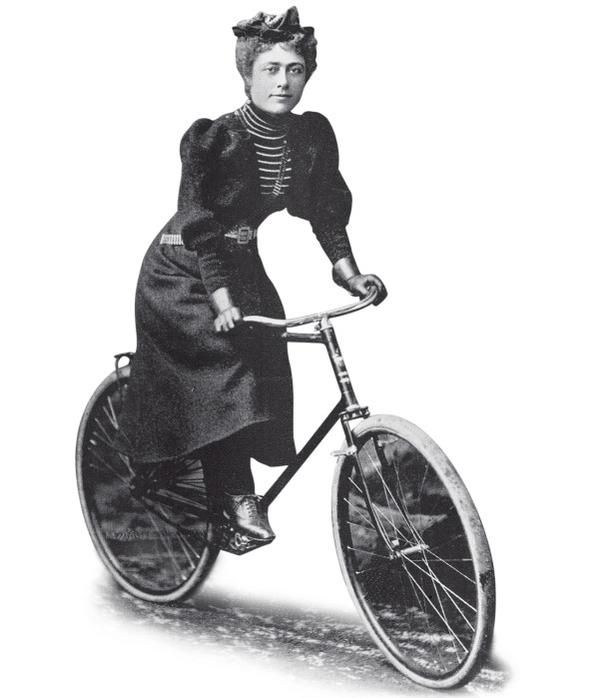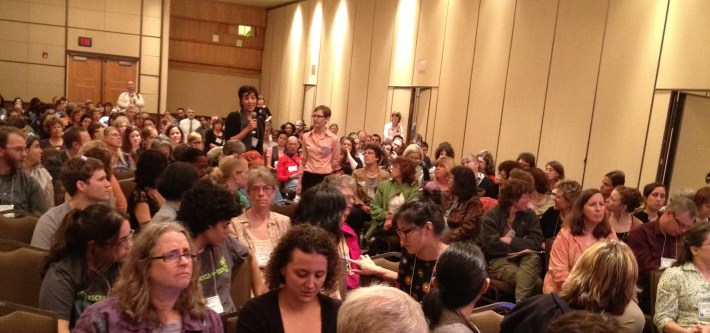Why Are Three Out of Four Cyclists on the Street Men?
10:00 AM EDT on March 21, 2012

I’ve never thought of myself as a female cyclist. For the last 13 years, I've been a bike commuter in DC, and I figured my needs were the same needs as any cyclist. But for the last six months, I’m a biker that doesn’t bike, and that has everything to do with the fact that I’m a woman. So the Women’s Cycling Forum, which kicked off the National Bike Summit yesterday, hit home for me.
After all, I had taken the metro. To the Bike Summit.
Why wasn’t I riding? I just had a baby. So did my partner, but somehow he never had to stop cycling. But then, he didn’t find himself gaining 28 pounds in nine months. Or pushing a baby out his bike-seat anatomy. And since he's not nursing every three hours, he leaves the house without Luna more often than I do, so he has more cause to bike. At two months, she’s too young for a bike trailer.
At least, I think she is. I have to admit I’m not sure when babies can start riding along. No one at the hospital made sure I had a child bike seat properly installed before I went home. None of the parenting websites and blogs I read list “old enough for a bike trailer” as a milestone. There are other cyclists in my mom’s group, but somehow no one talks about getting back in the saddle the way we talk about the challenges of going back to work or getting babies on a sleep schedule.
Now that I’m beginning to take short forays out of the house without Luna, I’m missing my bike. Bypassing the bus would make those short forays shorter, and more enjoyable.
But my bike needs a tune-up after six months of dormancy, and despite my best intentions, I’ve never learned to fix my own bike. I even bought a how-to book on bike repair – with a woman on the cover – but it’s my partner that used that book to teach himself bike maintenance, not me.
And I have to admit, these days when I see cyclists zip by inches from the side of the bus I’m on, it looks incredibly dangerous – far more dangerous than it ever felt when I was behind the handlebars. I know that when I get back on I’ll feel safe and confident again, but if I hadn't started urban cycling in college, I think I’d look at those daredevil madcap risk-takers on fixies and think it wasn’t for me.
Women make up only 24 percent of bicycle trips in the U.S., and all the issues I just mentioned are reasons why. And most of them came up in yesterday's Women’s Cycling Forum, organized by the Alliance for Biking and Walking and the Association of Pedestrian and Bicycle Professionals.
When people talk about the two-wheeled gender disparity, they often mention the safety issue and assume that better infrastructure – specifically, separated bike paths – will encourage more women to bike. And that’s a huge part of the solution, undoubtedly. But there’s more to it than that.
Many of us don’t know how to fix our own bikes and are intimidated and patronized when we step into a bike shop. We take disproportionate parenting duty and no one ever taught us how to ride safely with children, or what kind of gear (or cargo bikes) we need to schlep diaper bags and everything else that encumbers a parent. We don’t see cyclemoms around town to model ourselves after or ask questions of. There’s no guide to bike trailers in “What to Expect the First Year” or on Ask Dr. Sears, and no one brought one to my baby shower (even though I registered for it). And the 22-year-old dude at the bike shop with the perma-black hands might not be the world’s foremost expert on such things either.
I have a car seat for Luna but not a bike seat -- and I don’t have a car.
There are some resources for parents in cycling circles, but there are no resources for cyclists in parenting circles. If we want to broaden our message, we need to meet the women where they are -- especially the moms, who might feel the most limited when it comes to cycling.
Apparently I'm not be the only one wrestling with these issues. The Women’s Cycling Forum sold out days ago, with 220 people registered and more just showing up, hoping to get a seat.
Panelist Veronica Davis said she founded Black Women Bike DC after a little girl in an African-American neighborhood saw her riding by and yelled, “Mommy! Look at the black woman on a bike!” The girl was "very excited to see someone that looked like her on a bike." And with only 24 percent of the mode share, women in general don’t see enough of themselves on bikes – black women especially.
What we see too much of – in the pages of bicycling magazines as well as in the streets – are “MAMILs,” said Nelle Pierson of the Washington Area Bicyclists Association. (That’s Middle-Aged Men In Lycra.) And that’s who bike shops are marketing to. Pierson said she’s had some terrible experiences in bike shops. “That’s where you will get your first introduction to a bike, that’s where you can find the appropriate gear, and that’s where you can get turned off to biking,” Pierson said.
Maybe bike shops could look more like Lululemon stores, mused mountain bike racer Marla Streb. Or maybe they could at least clean their bathrooms once in a while. Or maybe they can sell gear appropriate to the needs of women commuters: “Can you make a bike with pedals that work for shoes like this?” she asked, holding up a kitten heel.
Streb said she spent $5,000 on her custom cargo bike, which she uses to shuttle around her two- and five-year-olds. “Kids are an equipment sport,” she said. But you don’t have to spend that much money, she was quick to point out. There are lots of cheaper options.
Safe infrastructure is important, and Veronica Davis said the campaign for complete streets is paramount. But even safety might not always be as important as it seems.
“I don’t think that women are necessarily more afraid [than men],” said Andrea Garland of Alta Planning + Design, “but we are more prone to say we’re afraid of something. I think it’s just not convenient for us.” Indeed, if women had a better idea how to fit two kids and their schoolbags and the groceries on a bike – and saw other women doing the same thing, and knew where to get the gear for it – they might be happy to do it, separated lanes or no separated lanes.
Women-only bike skills workshops are essential, said Streb, who teaches them. One man present will change the vibe. Besides, women are more “communal” than men, some participants commented. Group activities will inspire them to do something they might not do individually.
Perhaps because black women are even more invisible in cycling circles than white women, Davis had a very DIY attitude. When one participant expressed her indignation that she couldn’t get bike commuter jeans made for women, Davis indicated that she really didn’t expect marketers to have her in mind. “We need to step up and start our own bike shops; start own clothing lines. We can put the pressure on other people. But we can do it ourselves.”
Davis also suggested using social media to tell the stories and provide the community that marketers and the media won’t. “In the absence of marketers marketing [to us], that doesn’t mean we can’t do it,” she said. “That doesn’t mean we can’t say, 'Hey, this is how you can be fashionable and bike to work. This is how you can maintain your hairstyle under a helmet. Here are some bags you can take if you’re a mother.' It doesn’t mean we can’t tell our own story and market to ourselves.”
But a representative of the Dutch embassy – who couldn’t help mentioning a few times that women make up 55 percent of trips in the Netherlands – said that the most important thing to get women’s cycling rates up in the U.S. was to organize political support to get the infrastructure in place.
And that’s what the rest of the National Bike Summit will focus on. We’ll bring you team coverage of the Summit today.
Stay in touch
Sign up for our free newsletter
More from Streetsblog USA
Friday’s Headlines Got Served
Another day, another GOP lawsuit trying to overturn a Biden administration climate change rule.
Disabled People Are Dying in America’s Crosswalks — But We’re Not Counting Them
The data on traffic fatalities and injuries doesn’t account for their needs or even count them. Better data would enable better solutions.
LA: Automated Enforcement Coming Soon to a Bus Lane Near You
Metro is already installing on-bus cameras. Soon comes testing, outreach, then warning tickets. Wilshire/5th/6th and La Brea will be the first bus routes in the bus lane enforcement program.
Talking Headways Podcast: Charging Up Transportation
This week, we talk to the great Gabe Klein, executive director of President Biden's Joint Office of Energy and Transportation (and a former Streetsblog board member), about curbside electrification.
Why Does the Vision Zero Movement Stop At the Edge of the Road?
U.S. car crash deaths are nearly 10 percent higher if you count collisions that happen just outside the right of way. So why don't off-road deaths get more air time among advocates?





